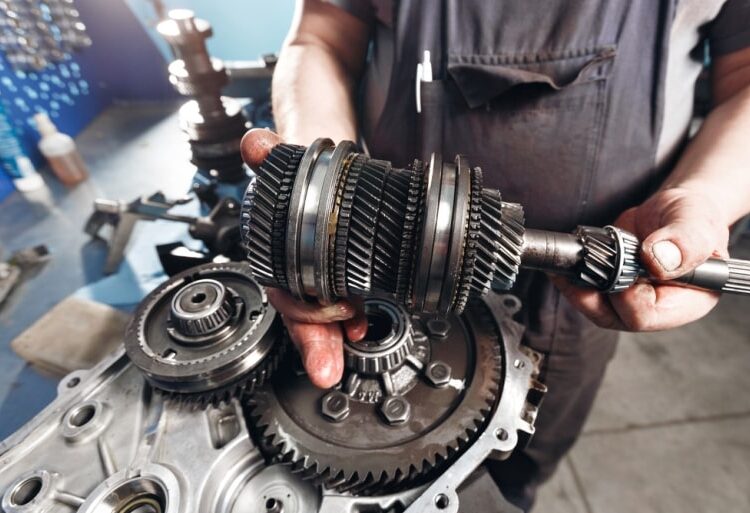A slipping transmission is a fairly common problem where your transmission system spontaneously changes gears without you shifting them, usually slipping into the neutral position. As a result, the vehicle starts coasting and revving without acceleration.
If you want to know how to fix a slipping transmission, you’ve come to the right place. In today’s guide, I’ll walk you through everything you need to know about slipping transmissions, including causes, troubleshooting, and what you can do to fix and avoid them.
What Causes a Slipping Transmission?
Before diving into the technical details of the troubleshooting process, you should first understand the reasons behind a slipping transmission. This is because different causes may require a different fix and may also vary in terms of urgency.
Low, Burnt, or Leaking Transmission Fluid
The first and most common reason for transmission slipping issues is problems with the fluid, whether it’s its level or quality.
Transmission fluid is essential for lubricating the parts inside a gearbox and preventing them from grinding, so a low level can cause erratic performance, including slipping into neutral and grinding noise while shifting.
A sign of leaking transmission fluid is having a red puddle underneath a parked car. The fluid can also get burnt from overheating due to contaminants, which change the fluid’s color to black or dark red.
Electronic Issues
Almost all modern cars will have an electronic system that controls the car’s performance, including its transmission.
In some cases, problems with the electronics might end up affecting how the transmission system performs, especially in automatic transmission cars.
Clutch Problems
The clutch is one of the most important parts of a manual transmission car, and contrary to what many people think, even automatic cars have clutches.
The clutch’s main job is to disengage the engine from the current transmission gear, allowing you to switch between them.
After certain mileage, the clutch disc ends up failing due to wear and friction. When this happens, it can result in performance issues, including slipping transmission.
Worn Transmission Bands
The transmission bands work with the clutches to ensure the synchronization of the transmission system.
Similar to clutches, these can also malfunction due to poor transmission habits and overheating due to low fluid.
Transmission band damage can range anywhere from minor wear and tear to complete breakage. In both cases, replacing the bands might be necessary.
Failing Torque Converter
As the name suggests, the torque converter is a part of the car that uses hydraulic pistons to convert the engine’s energy into propelling torque, which is necessary for smooth shifting between gears.
A failing torque converter can be a result of various factors, including low transmission fluid among various reasons. When torque converters malfunction, shifting between gears becomes much harder and you’ll find the gears slipping erratically while driving.
Faulty Solenoid
The solenoid is another critical part of the transmission system. Similar to the torque converter, it affects the hydraulic pressure needed to shift between gears by controlling the flow of fluid into the system.
Since the solenoid is an electrically controlled valve, it can also be considered part of the electronic system. This means that you’ll get a code for a faulty solenoid if you check it using an OBD II scanner, most commonly the code “P0750”.
Gears Damage and Wear
Your transmission system operates a series of gears of different sizes. These gears will naturally receive wear damage over the years due to high mileage, which reduces their performance and causes gears to slip out of position.
Driving on low transmission fluid increases the effect of friction on the gears, which causes them to wear quicker.
How to Fix a Slipping Transmission
Now that you know more about the different reasons behind a slipping transmission, here’s what you can do to identify the cause and steps to fix simple issues.
1. Start By Using an OBD Scanner to Look for Electronic Problems
As previously established, all modern cars will include plenty of electronic parts to control the performance of your vehicle, including the transmission system.
Unfortunately, electronic systems can be quite complex and require a professional car electrician to check them to determine the parts that need fixing or replacing.
To rule out that your slipping transmission problem isn’t electronic, you’ll need to use a reliable OBD scanner. Here’s how to plug it and use it:
- Locate the diagnostic OBD2 port on your car, which is usually below the steering column
- Plug the OBD scanner into the diagnostic link connector and turn it on
- Locate the DTC scan option in the menu and choose it
If you find any codes that indicate an electronic problem, you’ll need to have the car checked by a professional. However, if the scanner doesn’t give you any codes, you may proceed with other fixes.
2. Check the Transmission Fluid Level and Color
One of the most common, if not the most common, reasons behind slipping transmission is problems with transmission fluid. This is because they can affect the system both directly and indirectly.
Having a clear puddle of red fluid under the car is enough sign that your transmission fluid is leaking. However, you can also check its level through the following steps:
- Leave the car idling on a level surface
- Pull out the dipstick, and clean it with a towel, then reinsert it again
- Take the dipstick out and check the level and color of the fluid using the marks on the stick.
If the fluid is below the level, you’ll need to top it up with extra transmission fluid. However, if it’s burned or dark, you’ll need to drain it completely and replace it with new fluid.
3. Replace the Fluid If Necessary
If you want to change the transmission fluid, you’ll need to locate the transmission fluid pan underneath the vehicle.
Place a collection tray under the pan cap and unscrew the drain bolts to release the fluid inside, or loosen a few bolts of the fluid pan if you don’t have a drain bolt.
Once the fluid is completely removed, replace the filter and re-screw the transmission fluid pan back on. You’ll then need to replace the liquid with an adequate amount of fluid so that it’s full when checked again.
4. Take the Care for a Test Drive
After changing the fluid and making sure that there are no leaks, you should test drive the car for a few miles and check if the problem persists.
5. Take the Car to a Professional Mechanic if the Problem Persists
Whether you’ve checked the fluid level and it was of good quality and level or the problem didn’t go away after changing the fluid, it’s usually an indicator that the issue is in other parts, such as gears, solenoids, torque converters, etc.
In that case, you’ll need to take the car to a professional repair shop to have the car checked and the faulty part fixed or replaced.
Final Thoughts
This wraps it up for today’s guide about slipping transmissions and how to fix them. As you can see, the problem is mainly caused by problems in transmission fluid, but it can have other causes that may require professional help.
Remember to do regular maintenance and fluid changes every 30,000 to 60,000 miles to keep the system in the best shape.




